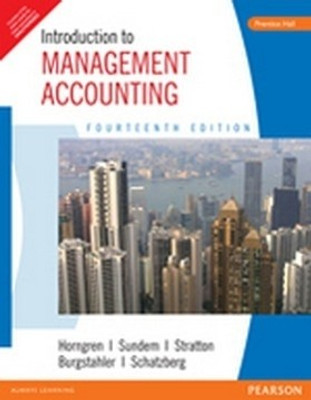Introduction to Management Accounting 14thEditon Edition(English, Paperback, Horngren)
Quick Overview
Product Price Comparison
Introduction To Management Accounting helps students understand the theory and principles of management accounting and enables them to apply it in practical situations. Summary Of the Book Management accounting gathers information that is meant for use within the organization. It involves an analysis of the financial records of the organization, to find and present meaningful information that will aid in decision making. Introduction To Management Accounting helps students understand the fundamental theories and practices of the subject. It is divided into five parts. The first part is Focus On Decision Making and the second part is Accounting For Planning and Control. The third part is Capital Budgeting. Part four discusses Product Costing and the final part provides an Introduction to Basic Financial Accounting. The first part begins with an examination of the relationship between Accounting and Decision Making, and the importance of business ethics. It then discusses the management of cost behavior and the concept of finding relevant information that can affect pricing and operational decisions. The second part discusses budgeting and management control systems. The third part concentrates on capital budgeting. The fourth part explains the various aspects of product costing. The final part covers basic financial accounting. Each chapter begins with a small section that defines the learning objectives of that chapter. This is followed by a box that describes the operational model of a specific company. This example is then used throughout the chapter to illustrate the various concepts. The section, Making Managerial Decisions, shows how to apply the concepts discussed so far in practical situations. Each chapter in Introduction To Management Accounting also contains sections that discusses ethical issues. Introduction To Management Accounting lays emphasis on first understanding the business before going into an exploration of how accounting can help make business decisions. It also helps the reader gain a good foundation in the concepts of cost behavior. This helps them understand the relevance of cost related information in planning decisions. About The Authors Charles T. Horngren is a professor and author. Other books by this author are Cost Accounting: A Managerial Emphasis and Introduction to Financial Accounting. Charles T. Horngren has an MBA from Harvard University and a doctorate from the University of Chicago. He is the professor of accounting at Stanford University. He has won many honors including a Faculty Excellence Award and a Distinguished Professor Award. Gary L. Sundem is a professor of accounting. His other publications include Introduction To Financial Accounting and The Value of Information and Audits. Gray Sundem is in the faculty of the University of WashingtonŌĆÖs School of Business, as a professor of accounting. He has an MBA and a Ph.D. from Stanford University. He has extensive teaching and administrative experience. He has won numerous awards like the WSCPA Outstanding Accounting Educator Award and the AAA Distinguished International Lecturer. Jeff Schatzberg is a professor of accounting. Jeffrey Schatzberg has a degree in philosophy, a postgraduate degree in accounting, and a doctorate in Business Administration. He is also a CPA. His writings have been published in many leading business and accounting journals. He has received many awards including the MBA Faculty of the Year Award and the Excellence in Teaching Award.


